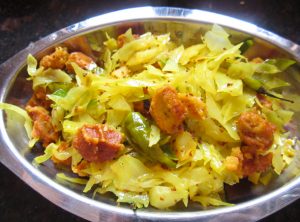Mama’s Punjabi Recipes: Bandh Gobi Te Wadiyan (Cabbage & Spicy Dumplings)
Saved under Community, Current Stories, Recipe Corner
Tags: Bandh Gobi Te Wadiyan, Baytown, Cabbage & Spicy Dumplings, Clear Lake, Cypress, Desi news, Greater Houston, Houston, Houston Desi news, India, Indian American community, Indian News, Indians in America, Indo-American News, Katy, Mama’s Punjabi Recipes, NRI, pearland, Shakuntla Malhotra, south asia, South India, Sugar Land, Texas, USA
This Punjabi recipe for a simple vegetable like cabbage has surprised people for how tasty it can be and many have asked the secret behind how it is made. So, by popular demand, below is a reprint of Mama’s Bandh Gobi te Wadiyan recipe. It is very different from the Gujarati style that is also widely made, though it is not normally available in most Indian restaurants. It is reprinted with some additional information and directions.
Bandh gobi (cabbage) – especially the purple variety – must be one of the least desirable of all vegetables because of its drab taste and pungent odor while cooking, though it is certainly among the cheapest. In some parts of India, like the Gujarat, it is chopped and made in a semi-cooked way with mustard seeds. The Punjabi style is completely different in the softening of the cabbage and adding more flavor.
Punjabis usually add other ingredients to bring more exciting flavor to the lowly cabbage taste. But the secret ingredient that brings an explosive burst of spiciness are the Punjabi wadiyan (spicy lentil dumplings), which can bring in spiciness, tanginess and a little extra texture to a cabbage dish.
There is an art to knowing how to prepare the wadiyan and then how to cook them so that they enhance the food but do not crumble into tiny pieces. Punjabi wadiyan are generally made of skinless manh or urad daal (black lentils) with dhania (coriander), garam masala, lal mirch (red pepper), adrak (ginger) and hing (astafoetida powder).
As with most types of cooking, timing is everything when using the wadiyan and the results speak for themselves when the dish is devoured! This dish is usually eaten with fresh roti.
Ingredients:
1 kg bandh gobi (green cabbage)
1 or 2 Punjabi wadiyan (lentil dumplings) – spiciness to taste
2 tbsp tael (olive oil or vegetable oil)
½ tsp sarson beej (mustard seeds)
½ tsp haldi (turmeric powder)
Spices to taste: 1 tsp namak (salt), 1 tsp mirch (red pepper), 1 tsp garam masala
Directions:
1. Cut the gobi into half and then chop into half inch strips, 2 inches long. Soak in water to wash and then pass through a strainer. Set it to the side.
2. Break the wadiyan into slightly smaller ½ inch pieces and keep to the side.
3. In a kadai (wok), heat the oil over medium setting then throw in the wadiyan and stir till they are slightly brown. Add the mustard seeds, turmeric, salt and pepper and mix well.
4. Now add the cut gobi and stir till it is coated. Cover and let it cook in its own steam for 5 minutes over high heat.
5. Check if the gobi has let off enough vapor and become soft and make sure that the wadi is also tender. If there is some water, take off the cover and turn the heat to low till the water is reduced, in about 10 minutes. Stir gently to make sure it doesn’t stick and burn.
6. When the water has dried up and the gobi is tender, turn the heat off and the dish is ready. Keep covered and turn the heat down to very low for five more minutes. Sprinkle with garam masala and serve.
MAMA’S TIP OF THE WEEK
HOW TO COOK TENDER PUNJABI WADIYAN
There are many types of Punjabi wadiyan (spicy lentil dumplings) available and each city in the state – as well as many Punjabi stores in Delhi – swear that their wadiyan are the best. It all depends on the type of spices you are used to and the mixture of lentils you use. My mother, Biji, used to make her own wadiyan at home and let the small round balls dry on a muslin cloth on a charpai (string cot) in the hot sun on the rooftop!
But after the wadiyan are made, you must brown them with a little oil in a pan so that they don’t give off a uncooked dough taste. Break them into smaller pieces in a dry dish or use whole in a curry, but stir gently so that they do not crumble. When cooked they should not stay dry and hard; but also do not steam till they become too mushy.

Shakuntla Malhotra is a skilled cook of Punjabi dishes made in the old-fashioned style that she learnt as a young woman in her ancestral home in Lyallpur (since renamed Faisalabad), India before it became part of Pakistan after the Partition in 1947. People have often admired her cooking for its simplicity and taste that comes with each mouthful. Even in her mid-eighties, she continues to cook daily and agreed to share some of her delectable Punjabi recipes

